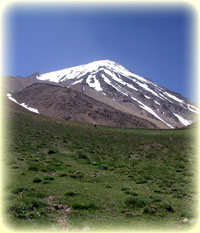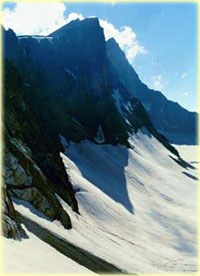|
Iran Weather
 The
Country Iran with 1648195 kilometers square areas is located in southern part of
north moderate zone between 25 03′ and 39 47′ of northern latitude from equator
circle and 44 14′ and 63 20′ eastern longitude from Greenwich meridian. Nearly
90 percent of Iran territory is situated in Iran Plateau district. Generally
Iran is mountainous and semidry land, which its mean altitude is more than 1200
meters above sea level. More than one half of Iran consists of mountains, one
quarter is plains and deserts and less than one quarter is farming lands. Lut
Desert with 56 meters altitude is the lowest internal point and Damavand Summit
in central Alborz Mountains with 5628 meters altitude is the highest point of
Iran. In southern coast of Caspian Sea, the altitude of the ground is 28 meters
lower than sea level. The
Country Iran with 1648195 kilometers square areas is located in southern part of
north moderate zone between 25 03′ and 39 47′ of northern latitude from equator
circle and 44 14′ and 63 20′ eastern longitude from Greenwich meridian. Nearly
90 percent of Iran territory is situated in Iran Plateau district. Generally
Iran is mountainous and semidry land, which its mean altitude is more than 1200
meters above sea level. More than one half of Iran consists of mountains, one
quarter is plains and deserts and less than one quarter is farming lands. Lut
Desert with 56 meters altitude is the lowest internal point and Damavand Summit
in central Alborz Mountains with 5628 meters altitude is the highest point of
Iran. In southern coast of Caspian Sea, the altitude of the ground is 28 meters
lower than sea level.
Natural Characteristics
From morphological and topographical approach, Iran is a relatively high
plateau, which is located in middle part of Alpine-Himalayan fold belt. The huge
ranges of Alpine-Himalayan fold belt that is continued from Europe to middle
Asia are divided in two branches, Alborz and Zagros Mountains in Iran.
Southern branch, Zagros Mountains as a big wall separate central Iran from
Mesopotamia plain. This range at southeast as a dam covers all coast of Persian
Gulf and by connecting with Makran zone continue toward Pakistan.
Northern branch, Alborz Mountain, at north, is the boundary between interior
land and Caspian Sea and after joint with NW-SE trending Kopeh Dagh range,
separates Central Iran from Karakorum and Karazm deserts. Some parts of high
elevation mountains of east Iran with NS trend are located between Lut block at
west and Helmand block at east. These mountains are limited at south and north
by Khab Playa and Makran Range respectively and complete the boundary of central
Iran.
The third belt between Zagros and Alborz with NW-SE trend is situated in
interior part of plateau-like central zone. This feature in contact with central
Iranian blocks, make up some trough and lakes which, present current morphology
of internal plains.
Climate
In the scale of general atmospheric currents, most of Iran territory
correlates with air subsidence regions and because of this, in an uniform
distribution pattern of climate, Iran is situated in the desert belt of northern
hemisphere. However Iran has climatological diversity with three types of
climate.
- Dry and semidry climate: large part of internal lands and southern border of
Iran have this climate. The specifications of these regions are long dry periods
that sometimes involve 7 months of the year. Also annual rain of the regions is
among 25-30 millimeters.
- Mountainous climate which itself is subdivided to two categories, cold
mountainous climate and moderate mountainous climate.
- Cold mountainous climate which dominants in 40000 km square areas of Iran has
more than 500 millimeters annual rain.
- Moderate mountainous climate: with 250-600 millimeters annual rain, it
dominants in 300000 km square areas of Iran.
- Caspianic climate: a narrow and small area between Caspian Sea and Alborz
Mountain Belt with 600-2000 millimeters annual rain.
Figure 2: mead rain map of Iran Figure 3: climatological map of Iran, diversity
in climates of Iran is as the result of extension in geographical latitude, long
mountain belts, altitude remarkable variation and the position of country
relative to seas and oceans.
 Environment Environment
Land and marine ecosystems, biodiversity, rivers and seas, swamps and
grasslands are the main elements of natural environment and so every play its
role in providing sustainable biological conditions. However the most part of
Iran with low mean annual rain, are desert and semidry lands of high central
plateau and threats against the environment are serious. But Iran from
biodiversity approach has a good situation and we can find samples of rich
biological resources. From viewpoint of numbers of plant genus, Iran is one of
the richest floras of the world and swamps of the country are considered as
important environmental resources.
|